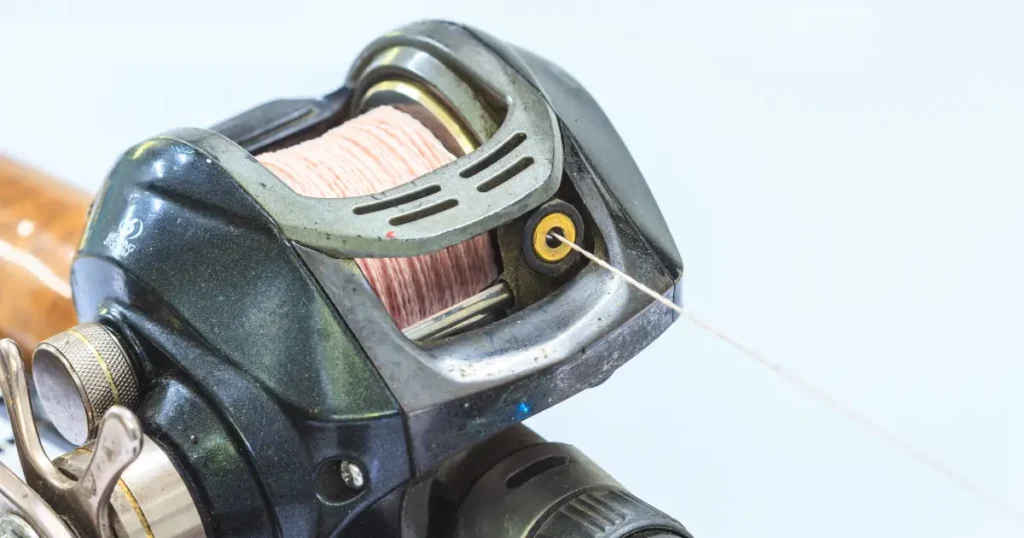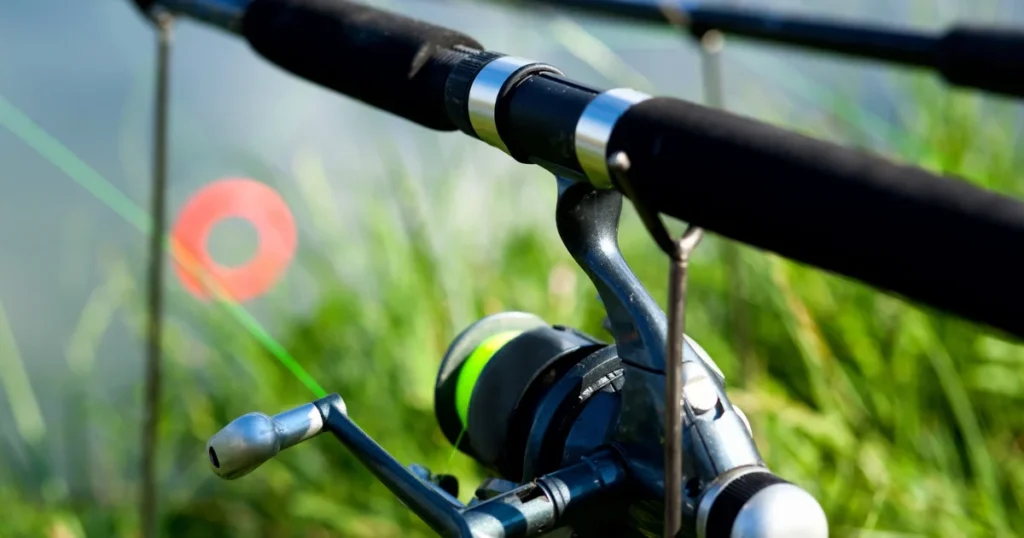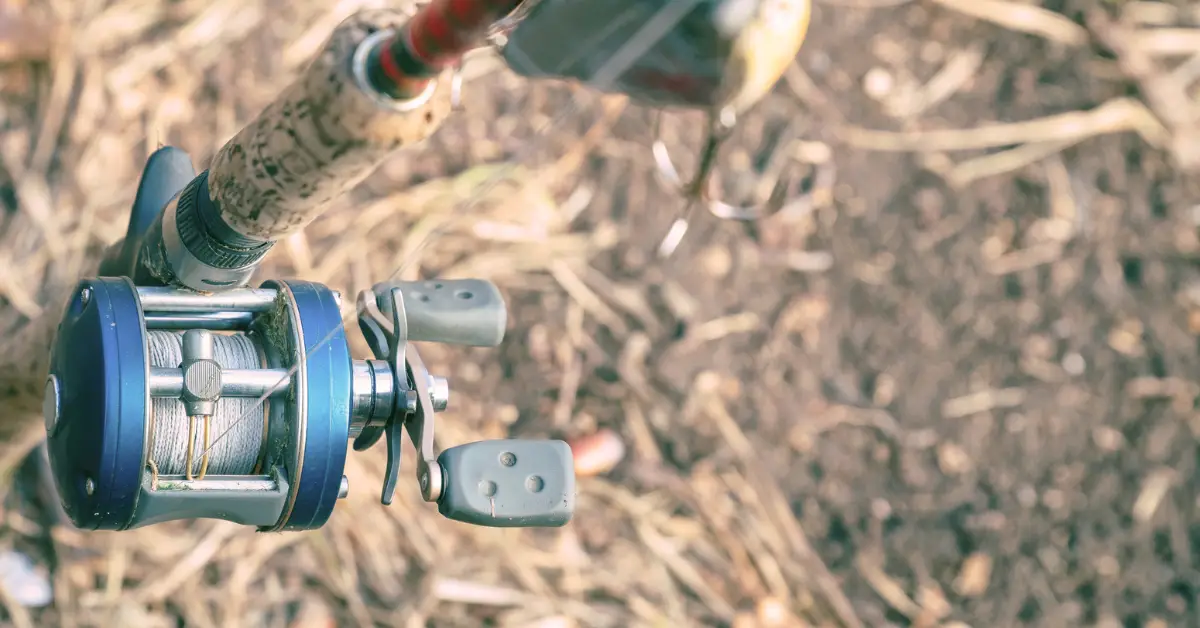When it comes to fishing, having the right gear can make a significant difference in your success and overall experience. Two of the most popular reel types are bait casters and spinning reels, and the debate over which one is better has been ongoing among anglers for years.
In this comprehensive guide, we’ll explore the pros and cons of each reel type, helping you determine which one is best suited for your fishing needs.
What Is a Baitcasting Reel?

A baitcasting reel, often referred to as a baitcaster, is a type of fishing reel where the spool rotates and follows the direction of the cast. The spool spins perpendicular to the rod, and the line is released from the revolving spool during the cast.
Baitcasters require more skill and attention to avoid backlashes (tangled lines) and wind knots, but they offer increased accuracy, control, and casting distance when mastered.
The design of a bait caster typically features a level-wind system that helps guide the line evenly onto the spool during retrieval. This prevents the line from digging into itself and causing tangles or friction.
Additionally, bait casters often have adjustable braking systems, such as centrifugal or magnetic brakes, that help control the spool speed and prevent backlashes.
While bait casters may take more practice to master, their precision and power make them a favorite among many experienced anglers, particularly in the world of bass fishing. The ability to accurately pitch, skip, and flip lures into the tight cover or under docks is a significant advantage of using a bait caster.
What Is a Spinning Reel?

A spinning reel has a fixed spool that remains stationary during the cast. The line is pulled off the spool and guides as the spinning rod is swept backward and forward. These reels are generally easier to use, especially for beginners, and are known for their smooth operation and line management capabilities.
The design of a spinning reel features a bail wire that opens and closes to allow the line to be released during the cast. The spool is mounted parallel to the rod, and the line comes off the spool in a straight path, reducing the risk of tangles or wind knots.
Spinning reels are often praised for their versatility and ease of use. They can handle a wide range of line weights and lure sizes, making them suitable for various fishing techniques and target species. From light trout fishing to moderate inshore saltwater fishing, spinning reels are a popular choice among many anglers.
Baitcasters Pros and Cons
Pros:
- Increased accuracy and casting distance: The design of bait casters allows for more precise lure placement and longer casts, making them ideal for targeting specific areas or covering larger distances.
- Better for heavier lines/lures: Baitcasters can handle heavier fishing lines and larger lures more effectively, making them suitable for techniques like flipping, pitching, and frog fishing.
- Superior drag systems: Many bait casters feature robust drag systems that provide better control when fighting powerful fish, reducing the risk of line breakage or lost fish.
Cons:
- Steeper learning curve: Mastering a bait caster requires practice to avoid backlashes and wind knots, which can be frustrating for beginners.
- Require more maintenance: Baitcasters have various adjustments, such as brakes and tension knobs, that need to be fine-tuned for optimal performance.
- Limited line capacity: Compared to some larger spinning reels, bait casters generally have a smaller line capacity, which can be a limitation for certain fishing situations.
Spinning Reels Pros and Cons
Pros:
- User-friendly for beginners: Spinning reels are generally easier to use and have a shallower learning curve, making them a popular choice for new anglers.
- Minimal maintenance required: With a simpler design, spinning reels require less frequent maintenance compared to bait casters.
- Ideal for light line/finesse techniques: Spinning reels excel when using lighter lines and smaller lures, which are often used in finesse fishing techniques.
- Increased line capacity: Many spinning reels, especially larger models, can hold more lines compared to bait casters, which can be beneficial for certain fishing styles or locations.
Cons:
- Limited casting distance: Due to their design, spinning reels generally have a shorter casting distance compared to bait casters.
- Not suited for very heavy lines/lures: While capable of handling moderate weights, spinning reels may struggle with extremely heavy lines or large lures.
- Line twist potential: If not properly managed, spinning reels can be prone to line twist, which can affect lure action and casting distance.
Baitcaster vs Spinning Reel for Distance
When it comes to casting distance, bait casters have a distinct advantage over spinning reels. The revolving spool and braking systems on bait casters provide better control over the lure or bait, allowing for longer casts with greater accuracy. Techniques like pitching, skipping, and flipping are also easier to execute with a bait caster.
The ability to cast further can be particularly advantageous when fishing larger bodies of water, targeting specific structures or cover from a distance, or when using heavier lures that require more momentum to reach their desired target.
Many bass anglers, for example, rely on the extended casting distance of bait casters to effectively present their lures in areas that would be challenging to reach with a spinning reel.
However, it’s important to note that casting distance is also influenced by factors such as rod length, line weight, and the angler’s technique. A skilled angler can often achieve impressive casting distance with a well-tuned spinning reel and the proper rod and line combination.
Baitcaster vs Spinning Reel for Beginners
For beginners, spinning reels are generally the more user-friendly option. Their simple design and lack of backlash potential make them easier to use right out of the gate. Baitcasters, on the other hand, require practice and skill to master the art of controlling the spool and avoiding tangled lines.
The learning curve for bait casters can be steep, as beginners must learn to manage the revolving spool and apply the appropriate brake settings to prevent backlashes. Even experienced anglers can find themselves dealing with frustrating wind knots or tangled lines when using a bait caster, especially in challenging conditions or when transitioning to a new reel.
If you’re new to fishing, it’s recommended to start with a spinning reel and gradually transition to a bait caster as your skills improve. Many experienced anglers also prefer to use spinning reels for certain techniques or situations, as they can be highly effective when used correctly and offer a more relaxed fishing experience.
Spinning vs. Baitcasting: When to Use?
The decision between using a spinning reel or a bait caster often comes down to the specific fishing situation and personal preferences. Here are some general guidelines:
- Bass Fishing: For bass fishing, especially when targeting fish in heavy cover or using techniques like pitching and flipping, bait casters are often preferred due to their increased accuracy and ability to handle heavier lines and lures.
- Finesse Fishing: When fishing with lighter lines and smaller lures, such as when targeting speckled trout or using finesse techniques, spinning reels are an excellent choice.
- Saltwater Fishing: Both bait casters and spinning reels can be used for saltwater fishing, depending on the target species and techniques employed. Baitcasters may be preferred for larger fish or heavier lures while spinning reels are suitable for lighter inshore or surf fishing.
- Beginner Anglers: As mentioned earlier, spinning reels are generally recommended for beginners due to their ease of use and lower risk of backlashes.
- Lure Weight and Type: For heavier lures like crankbaits, jigs, or Texas-rigged soft plastics, bait casters are often the preferred choice due to their ability to handle the added weight and maintain lure action. For lighter lures like small crankbaits, spinners, or live bait rigs, spinning reels can be more efficient.
- Fishing Environment: In areas with dense vegetation, overhanging trees, or tight spaces, the accuracy and precision of bait casters can be beneficial. For open water or more forgiving environments, spinning reels may be more suitable.
Ultimately, the decision should be based on your specific fishing goals, the techniques you plan to use, and your personal skill level and preferences. Many anglers choose to have both types of reels in their arsenal, using each one for the specific situations where it excels.
How to Prevent Line Twist on Spinning Reels
One common issue with spinning reels is line twists, which can cause tangles, reduce casting distance, and affect lure action. To minimize line twist:
- Use a braided fishing line or a monofilament line with a thin diameter. Thinner lines tend to be less prone to twisting.
- Avoid letting the line come off the spool in loops or coils during the cast. Aim for a smooth, controlled release of the line.
- Use a line conditioner or add a swivel between the lure and the line. Swivels can help prevent twists from transferring to the lure.
- Experiment with different reel handle rotations and retrieve techniques. Some anglers prefer to switch the direction of the handle rotation periodically to counteract the twist.
- Consider using a spinning reel with a larger spool diameter, as larger spools tend to be less prone to line twist.
Additionally, it’s essential to maintain proper line management by avoiding excessive loose coils on the spool and regularly checking for wind knots or tangles. Proper care and maintenance can go a long way in preventing line twist issues with spinning reels.
Fighting Fish with a Baitcaster Reel
Baitcasters offer several advantages when it comes to fighting and landing fish, particularly larger or more powerful species. The increased drag control and leverage provided by bait casters allow anglers to apply more pressure and tire out fish more effectively.
When using a bait caster, it’s important to:
- Adjust the drag properly to avoid breaking the line or pulling the hook. Many bait casters feature robust drag systems that can handle significant pressure.
- Keep the rod at an angle that allows you to maintain control and leverage. A lower rod angle can help you apply more pressure and leverage against the fish.
- Use the reel’s cranking power to gain line when the fish tires. The gear ratio and retrieving power of bait casters can help you quickly regain line during the fight.
- Be prepared for sudden runs or headshakes by being ready to engage the reel and apply pressure. Baitcasters allow for quick reactions and adjustments during the fight.
When fighting larger fish like trophy bass, saltwater species, or powerful freshwater predators, the advantages of a bait caster become even more apparent. The increased control and power can mean the difference between landing the fish of a lifetime or experiencing a heartbreaking loss.
It’s important to note that proper fish-fighting techniques, such as keeping the rod bent and applying steady pressure, are crucial regardless of the reel type used. However, the design and capabilities of bait casters can provide a significant advantage in certain situations.
Baitcasting Reel Designs
Baitcasters come in various designs, each with its advantages and intended uses:
- Low-Profile Baitcasters: These compact reels are popular among bass anglers for their lightweight and ergonomic design, making them comfortable to use for extended periods. Low-profile bait casters often feature a sleek, palmable shape that fits well in the hand and provides excellent balance when paired with the right rod.
- Round Baitcasters: With a more traditional round shape, these reels are often used for larger fish species or heavier lines, as they offer increased cranking power and line capacity. Round bait casters may be heavier than their low-profile counterparts but provide added strength and durability for demanding fishing situations.
- Specialty Baitcasters: Some bait casters are designed for specific techniques or fishing styles, such as flipping, pitching, or crankbait fishing. These reels may feature unique spool designs, braking systems, or gear ratios tailored to their intended application.
When selecting a bait caster, consider the type of fishing you’ll be doing, the lure or bait weights you’ll be using, and your personal preferences in terms of size, weight, and balance.
Additionally, factors like gear ratio, braking systems, and overall construction quality should be evaluated based on your specific needs and budget.
Top Baitcaster and Spinning Reel Recommendations
Here are some highly-rated bait caster and spinning reel models to consider for different budgets and experience levels:
Baitcasters:
- (Daiwa Tatula CT Type) Pros: Lightweight, durable, smooth performance.
- Cons: Pricey for some anglers.
- (Lew’s Mach II Speed Spool) Pros: Affordable, excellent braking system.
- Cons: May not be as smooth as higher-end models.
- (Abu Garcia Revo Toro) Pros: Powerful, suitable for heavy cover and large fish.
- Cons: Heavier than some other options.
Spinning Reels:
- (Pflueger President) Pros: Smooth, reliable, great value.
- Cons: Limited to lighter line weights.
- (Penn Slammer III) Pros: Durable, suitable for inshore saltwater use.
- Cons: Slightly heavier than some spinning reels.
- (Daiwa BG) Pros: Lightweight, smooth performance.
- Cons: More expensive than some other spinning reels.
These are just a few examples, and the best choice will depend on your specific needs, budget, and preferences.
It’s always a good idea to research various models, read reviews, and, if possible, handle the reels in person to get a feel for their performance and ergonomics.
When selecting a reel, consider factors such as the intended fishing application (freshwater, saltwater, inshore, offshore), the expected lure or bait weights, the desired gear ratio, and the overall construction quality and materials used. Additionally, personal preferences like reel weight, balance, and aesthetics can play a role in determining the right reel for your needs.
Finale
Both bait casters and spinning reels have their strengths and ideal applications. Baitcasters offer increased accuracy, casting distance, and the ability to handle heavier lines and lures, making them well-suited for techniques like flipping, pitching, and frog fishing.
They also provide superior drag systems and leverage for fighting powerful fish. However, they require more skill and practice to avoid backlashes and wind knots.
Spinning reels, on the other hand, are generally easier to use and require less maintenance, making them an excellent choice for beginners or when using lighter lines and smaller lures. They excel in finesse fishing techniques and can be highly effective when used correctly. While they may not cast as far as bait casters, many anglers find them to be versatile and user-friendly options for a wide range of fishing situations.
Ultimately, the decision between a bait caster and a spinning reel comes down to your fishing goals, skill level, and personal preferences. Many experienced anglers choose to have both types of reels in their arsenal, using each one for the specific situations where it excels.











